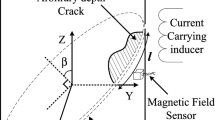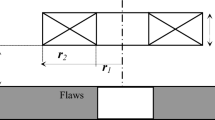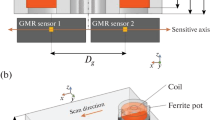Abstract
This study developed a procedure for rapidly reconstructing a crack profile for calculating the parameters of fracture mechanics such as stress intensity factor with energy release rate (J) and displacement opening crack tip using data from the eddy current sensor. The inverse problem focused on adopting genetic algorithms to solve the direct problem iteratively. The use of the differential probe allows a rapid and precise resolution of the direct problem. The incident field produced by the two coils is determined using the 3D finite element results and the variation of impedance in each coil due to the crack. For the inverse problem, the crack’s surface is considered regular shape in terms of dimensions, and the sensor’s impedance expresses the objective function in terms of the width and length of the crack. The evaluation of the shape function and mesh matrix is made dependent on the iterative process, which makes the reversal procedure computationally lightweight when using genetic algorithms.











Similar content being viewed by others
References
Yao, L., Jiang, G., Wu, F., Luo, J.: An optimized finite element method for the analysis of 3D acoustic cavities with impedance boundary conditions. Appl. Math. Model. 84, 447–465 (2020). https://doi.org/10.1016/j.apm.2020.04.012
Tong, Z., Xie, S., Liu, H., Zhang, W., Pei, C., Li, Y., Chen, Z., Uchimoto, T., Takagi, T.: An efficient electromagnetic and thermal modelling of eddy current pulsed thermography for quantitative evaluation of blade fatigue cracks in heavy-duty gas turbines. Mech. Syst. Signal Process. 142, 106781 (2020). https://doi.org/10.1016/j.ymssp.2020.106781
Tong, Z., Xie, S., Chen, H., Qiu, J., Cai, W., Pei, C., Chen, Z., Uchimoto, T., Takagi, T.: Quantitative mapping of depth profile of fatigue cracks using eddy current pulsed thermography assisted by PCA and 2D wavelet transformation. Mech. Syst. Signal Process. 175, 109139 (2022). https://doi.org/10.1016/j.ymssp.2022.109139
Ju, S., Li, D., Jia, J.: Machine-learning-based methods for crack classification using acoustic emission technique. Mech. Syst. Signal Process. 178, 109253 (2022). https://doi.org/10.1016/j.ymssp.2022.109253
Guesmi, M., Harzallah, S., Kouzou, A.: New non-destructive testing approach based on eddy current for crack orientation detection and parameter estimation. Int. J. Appl. Electromagn. Mech.Electromagn. Mech. 67(4), 431–451 (2021). https://doi.org/10.3233/JAE-210049
Harzallah, S., Chabaat, M.: 3D Eddy current modeling for evaluating the fracture parameters by new method based on the variation of the impedance ». Int. J. Appl. Electromagn. Mech.Electromagn. Mech. 53(2), 371–385 (2017)
Lavers, J.D., Ahmed, M.R.: A boundary element method to predict the shape of a molten metal free surface in EM confinement field. IEEE Trans. Magn.Magn. 24(6), 2521–2523 (1988)
Racheka, M., Féliachi, M.: 3-D movement simulation techniques using FE methods: application to eddy current non-destructive testing. NDT&E Int. 40, 35–42 (2007)
Ratnajeevan, S., Hoole, H., Karthik, V.U., Sivasuthan, S., Rahunanthan, A., Thyagarajan, R., Jayakumar, P.: Finite elements, design optimization, and non-destructive evaluation: a review in magnetics, and future directions in GPU-based, element-b yelement coupled optimization and NDE. Int. J. Appl. Electromagn. Mech.Electromagn. Mech. 47(3), 607–627 (2015)
Cormerais, R., Longo, R., Duclos, A., Wasselynck, G., Berthiau, G.: Non destructive eddy currents inversion using artificial neural networks and data augmentation. NDT&E Int. 129, 102635 (2022). https://doi.org/10.1016/j.ndteint.2022.102635
Ge, J., Yusa, N., Fan, M.: Frequency component mixing of pulsed or multi-frequency eddy current testing for nonferromagnetic plate thickness measurement using a multi-gene genetic programming algorithm. NDT&E Int. 120, 102423 (2021). https://doi.org/10.1016/j.ndteint.2021.102423
Yi, Q., Tian, G.Y., Malekmohammadi, H., Laureti, S., Ricci, M., Gao, S.: Inverse reconstruction of fibre orientation in multilayer CFRP using forward FEM and eddy current pulsed thermography. NDT&E Int. 122, 102474 (2021). https://doi.org/10.1016/j.ndteint.2021.102474
Zaoui, A., Menana, H., Feliachi, M., Berthiau, G.: Inverse problem in nondestructive testing using arrayed eddy current sensors. Sensors 10, 8696–8704 (2010). https://doi.org/10.3390/s100908696
Abbassi, A., Bouchala, T., Abdou, A., et al.: Eddy current characterization of 3D crack by analyzing probe signal and using a fast algorithm search. Russ. J. Nondestruct. Test.Nondestruct. Test. 56, 426–434 (2020). https://doi.org/10.1134/S106183092005002
D’Angelo, G., Palmieri, F.: Knowledge elicitation based on genetic programming for non destructive testing of critical aerospace systems. Future Gener. Comput. Syst. 102, 633–642 (2020). https://doi.org/10.1016/j.future.2019.09.007
Wang, Z., Ye, P., Qiu, F., Tian, G., Woo, W.L.: Crack characterization in ferromagnetic steels by pulsed eddy current technique based on GA-BP neural network model. J. Magn. Magn. Mater.Magn. Magn. Mater. 500, 166412 (2020). https://doi.org/10.1016/j.jmmm.2020.166412
Westergaard, H.M.: New formulas for stresses in concrete pavements of airfields. Trans. Amer. Soc. Civil Eng. 113(1), 425–439 (1948). https://doi.org/10.1061/TACEAT.0006179
Griffith, A.A.: The phenomena of rupture and flow in solids. Philos. Trans. Ser. A 221, 163–198 (1920)
Irwin, G.R.: Analysis of stresses and strains near the end of a crack traversing a plate. J. Appl. Mech. 24, 361–364 (1957)
Sih, G.C., Paris, P.C., Irwin, G.R.: On cracks in rectilinearly anisotropic bodies. Int. J. Fract. Mech.Fract. Mech. 1, 189–203 (1965)
Rice, J.R.: A path independent integral and the approximate analysis of strain concentration by notches and cracks. J. Appl. Mech. 35, 379–386 (1968)
Stepanova, L., Bronnikov, S.: Mathematical modeling of the crack growth in linear elastic isotropic materials by conventional fracture mechanics approaches and by molecular dynamics method: crack propagation direction angle under mixed mode loading. J. Phys. Conf. Ser. 973(1), 012046 (2018)
Bernieri, A., Ferrigno, L., Laracca, M., Molinara, M.: Crack shape reconstruction in eddy current testing using machine learning systems for regression. IEEE Trans. Instrum. Meas.Instrum. Meas. 57(9), 1958–1968 (2008)
ASTM E1820-11: Standard test Method for Measurement of Fracture Toughness. American Society for Testing and Materials, West Conshohocken (2011)
Gholami, M., Fathi, A., Baghestani, A.M.: Multi-objective optimal structural design of composite superstructure using a novel MONMPSO algorithm. Int. J. Mech. Sci. 193, 106149 (2021). https://doi.org/10.1016/j.ijmecsci.2020.106149.a
Wu, K., Hu, H., Wang, L., Gao, Y.: Parametric optimization of an aperiodic metastructure based on genetic algorithm. Int. J. Mech. Sci. 214, 106878 (2022). https://doi.org/10.1016/j.ijmecsci.2021.106878
Pokkalla, D.K., Poh, L.H., Quek, S.T.: Isogeometric shape optimization of missing rib auxetics with prescribed negative Poisson’s ratio over large strains using genetic algorithm. Int. J. Mech. Sci. 193, 106169 (2021). https://doi.org/10.1016/j.ijmecsci.2020.106169
Mondal, M.K., Biswas, N., Datta, A., Sarkar, B.K., Manna, N.K.: Positional impacts of partial wall translations on hybrid nanofluid flow in porous media: real coded genetic algorithm (RCGA). Int. J. Mech. Sci. 217, 107030 (2022). https://doi.org/10.1016/j.ijmecsci.2021.107030
Nath, A., Ray, K.K., Barai, S.V.: Evaluation of ratcheting behaviour in cyclically stable steels through use of a combined kinematic-isotropic hardening rule and a genetic algorithm optimization technique. Int. J. Mech. Sci. 152, 138–150 (2019). https://doi.org/10.1016/j.ijmecsci.2018.12.047
Ehsani, A., Rezaeepazhand, J.: Stacking sequence optimization of laminated composite grid plates for maximum buckling load using genetic algorithm. Int. J. Mech. Sci. 119, 97–106 (2016). https://doi.org/10.1016/j.ijmecsci.2016.09.028
Holland, J.: Genetic algorithms and the optimal allocation of trials. SIAM J. Comput.Comput. 2(2), 88–105 (1973)
Goldberg, D.E.: Genetic Algorithms in Search, Optimization, and Machine Learning, 1st edn. Addison-Wesley Professional, Reading (1989)
Yang, X.-S., Chien, S.F., Ting, T.O.: Chapter 1—Bio-inspired computation and optimization: an overview. In: Yang, X.-S., Chien, S.F., Ting, T.O. (eds.) Bio-inspired Computation in Telecommunications, pp. 1–21. Morgan Kaufmann, Burlington (2015)
Guo, Y., Cai, Q., Samuels, D.C., et al.: The use of next generation sequencing technology to study the effect of radiation therapy on mitochondrial DNA mutation. Mutat. Res. Genet. Toxicol. Environ. Mutagen.. Res. Genet. Toxicol. Environ. Mutagen. 744(2), 154–160 (2012)
Pham, T.D., Hong, W.-K.: Genetic algorithm using probabilistic-based natural selections and dynamic mutation ranges in optimizing precast beams. Comput. Struct.. Struct. 258, 106681 (2022). https://doi.org/10.1016/j.compstruc.2021.106681
Bielefeldt, B.R., Reich, G.W., Beran, P.S., Hartl, D.J.: Development and validation of a genetic L-System programming framework for topology optimization of multifunctional structures. Comput. Struct.. Struct. 218, 152–169 (2019). https://doi.org/10.1016/j.compstruc.2019.02.005
Katoch, S., Chauhan, S.S., Kumar, V.: A review on genetic algorithm: past, present, and future. Multimed. Tools Appl. 80, 8091–8126 (2021). https://doi.org/10.1007/s11042-020-10139-6
Shrestha, A., Mahmood, A.: Improving genetic algorithm with fine-tuned crossover and scaled architecture. J. Math. 2016, 10 (2016). https://doi.org/10.1155/2016/4015845
Hassanat, A., Almohammadi, K., Alkafaween, E.A., Abunawas, E., Hammouri, A., Prasath, V.S.: Choosing mutation and crossover ratios for genetic algorithms—a review with a new dynamic approach. Information 10(12), 390 (2019). https://doi.org/10.3390/info10120
Ali, M.Z., Awad, N.H., Suganthan, P.N., Shatnawi, A.M., Reynolds, R.G.: An improved class of real-coded genetic algorithms for numerical optimization. Neurocomputing 275, 155–166 (2018)
Cho, I.H., Song, I., Teng, Y.L.: Numerical moment matching stabilized by a genetic algorithm for engineering data squashing and fast uncertainty quantification. Comput. Struct.. Struct. 204, 31–47 (2018). https://doi.org/10.1016/j.compstruc.2018.04.002
Preda, G., Rebican, M., Hantila, F.I.: Integral formulation and genetic algorithms for defects geometry reconstruction using pulse eddy currents. IEEE Trans. Magn.Magn. 46(8), 3433–3436 (2010). https://doi.org/10.1109/TMAG.2010.2044143
Pan, L., Xu, W., Li, L., He, C., Cheng, R.: Adaptive simulated binary crossover for rotated multi-objective optimization. Swarm Evol. Comput.Evol Comput 60, 100759 (2021). https://doi.org/10.1016/j.swevo.2020.100759
Lin, J., Huang, S., Jiau, M.: An evolutionary multiobjective carpool algorithm using set-based operator based on simulated binary crossover. IEEE Trans Cybern 49(9), 3432–3442 (2019). https://doi.org/10.1109/TCYB.2018.2844324
Yi, J.-H., Xing, L.-N., Wang, G.-G., Dong, J., Vasilakos, A.V., Alavi, A.H., Wang, L.: Behavior of crossover operators in NSGA-III for large-scale optimization problems. Inf. Sci. Sci 509, 470–487 (2020). https://doi.org/10.1016/j.ins.2018.10.005
Jiang, Q., Wang, L., Hei, X., Yu, G., Lin, Y., Lu, X.: MOEA/D- ARA+SBX: a new multi-objective evolutionary algorithm based on decomposition with artificial raindrop algorithm and simulated binary crossover. Knowl Based Syst 107, 197–218 (2016). https://doi.org/10.1016/j.knosys.2016.06.007
Harzallah, S., Chabaat, M.: 3D-FEM computation and experimental of Eddy currents for characterization of surface cracks. Int. J. Struct. Integr. (2017). https://doi.org/10.1108/IJSI-02-2017-0013
Harzallah, S., Rebhi, R., Chabaat, M., Rabehi, A.: Eddy current modelling using multi-layer perceptron neural networks for detecting surface cracks. Frattura Integr. Strut. 45, 147–155 (2018). https://doi.org/10.3221/IGF-ESIS.45.12
Augustyniak, M., Usarek, Z.: Finite element method applied in electromagnetic NDTE: a review. J. Nondestruct. Eval.Nondestruct. Eval. 35, 39 (2016). https://doi.org/10.1007/s10921-016-0356-6
Sidi-Ahmed, K., Maouche, B., Gabi, Y., Alloui, L., Straß, B., Wolter, B., Feliachi, M.: Numerical simulations and experimental investigation of laser hardening depth investigation via 3MA-eddy current technique. J. Magn. Magn. Mater.Magn. Magn. Mater. 550, 169046 (2022). https://doi.org/10.1016/j.jmmm.2022.169046
Tong, Z., Xie, S., Li, X., Pei, C., Chen, Z., He, Y.: Efficient numerical simulation of eddy current pulsed thermography NDT signals based on FEM-BEM method and energy equivalent principle. Infrared Phys. Technol. 101, 138–145 (2019). https://doi.org/10.1016/j.infrared.2019.06.009
Gay, S.E., Ehsani, M.: Parametric analysis of eddy-current brake performance by 3-D finite- element analysis. IEEE Trans. Magn.Magn. 42(2), 319–328 (2006)
Huang, R., Lu, M., Peyton, A., Yin, W.: A novel perturbed matrix inversion based method for the acceleration of finite element analysis in crack-scanning eddy current NDT. IEEE Access 8, 12438–12444 (2020). https://doi.org/10.1109/ACCESS.2020.2966032
Harzallah, S., Chabaat, M., Chabane, K.: Numerical study of eddy current by finite element method for cracks detection in structures. Frattura Integr. Strut. 11(39), 282–290 (2017)
GhafooriAhangar, R., Verreman, Y.: Assessment of mode I and mode Ii stress intensity factors obtained by displacement extrapolation and interaction integral methods. J Fail. Anal. Preven. 19, 85–97 (2019). https://doi.org/10.1007/s11668-018-0571-9
Sabbagh-Yazdi, S.R., Farhoud, A., Gharebaghi, S.A.: Simulation of 2D linear crack growth under constant load using GFVM and two-point displacement extrapolation method. Appl. Math. Model. 61, 650–667 (2018). https://doi.org/10.1016/j.apm.2018.05.022
Xie, G., Zhou, F., Zhang, D., Wen, X., Li, H.: A novel triangular boundary crack front element for 3D crack problems based on 8-node serendipity element. Eng. Anal. Bound. Elem. 105, 296–302 (2019). https://doi.org/10.1016/j.enganabound.2019.04.017
Soman, S., et al.: A simple technique for estimation of mixed mode (I/II) stress intensity factors. J. Mech. Mater. Struct.Struct. 13, 141–154 (2018)
Funding
Funding was provided by Direction Générale de la Recherche Scientifique et du Développement Technologique (Grant No. 3234).
Author information
Authors and Affiliations
Corresponding author
Ethics declarations
Conflict of interest
The authors have no relevant financial or non-financial interests to disclose.
Additional information
Publisher's Note
Springer Nature remains neutral with regard to jurisdictional claims in published maps and institutional affiliations.
Rights and permissions
Springer Nature or its licensor (e.g. a society or other partner) holds exclusive rights to this article under a publishing agreement with the author(s) or other rightsholder(s); author self-archiving of the accepted manuscript version of this article is solely governed by the terms of such publishing agreement and applicable law.
About this article
Cite this article
Aouissi, M., Harzallah, S. & Cheddad, A. Crack growth optimization using eddy current testing and genetic algorithm for estimating the stress intensity factors. Acta Mech (2024). https://doi.org/10.1007/s00707-024-03903-4
Received:
Revised:
Accepted:
Published:
DOI: https://doi.org/10.1007/s00707-024-03903-4




